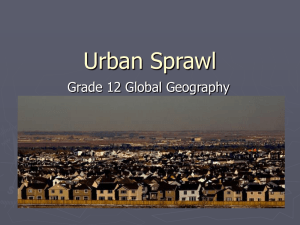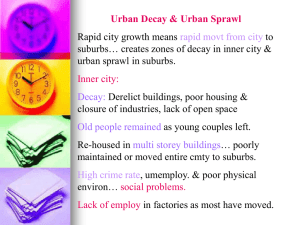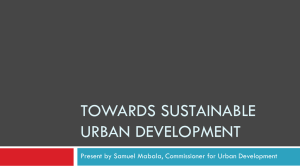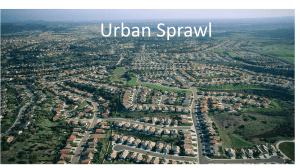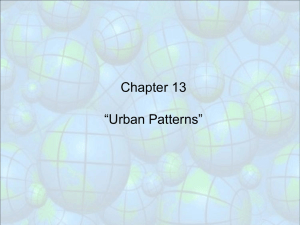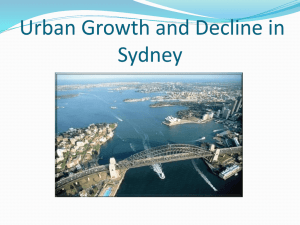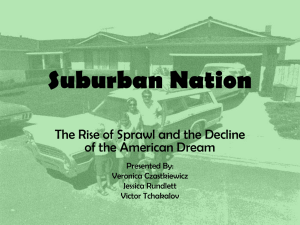Accessibility and Land Prices
advertisement
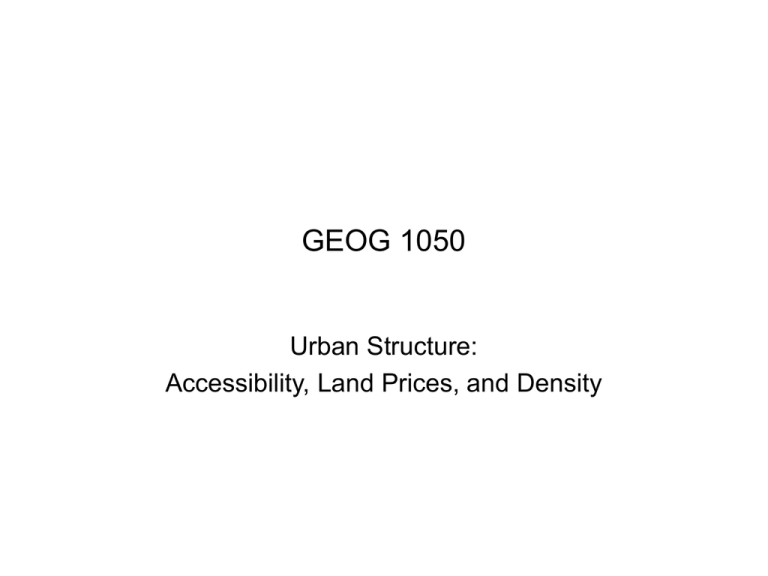
GEOG 1050 Urban Structure: Accessibility, Land Prices, and Density Accessibility and Land Prices • Accessibility—to customers, to suppliers, to work, to all the city has to offer—is important. • People and business will pay for accessibility, so land near transportation routes and nodes is more expensive. • When land is more expensive, it is used more intensively— e.g. denser development, or high rise building. An example: Toronto • The Central Business District or CBD of Toronto occupies the historic centre. The city has grown outward from this point. • The transportation system (road, rail, subway) focuses on the CBD, so this is a highly accessible location. • Also, the numerous businesses (e.g. banks), institutions (e.g. U. of T.) and cultural activities (e.g. galleries) concentrated in the CBD are highly accessible to each other by foot. Banks Queen St. W. Art Gallery of Ontario U of T The View from the CN Tower The relationship between the pattern of development and the accessibility provided by the transportation system can be seen on the ground in the view from the CN tower. Areas of greater accessibility are more densely developed. The Financial District In Toronto, as in most large cities, the area with the highest density—and the highest buildings—is the financial district. The Waterfront The original waterfront was off the picture to the lower left. All the land here is fill. This area had port activity in the twentieth century, but now it is being redeveloped as an expensive residential area, because of the amenity (lake views) and the accessibility (directly adjacent to the downtown core). For these reasons too the land is extremely valuable. The Effect of the Subway When the subway system was built under Yonge, University and Bloor Streets, accessibility was enhanced for locations along these streets. This increased land values, and consequently the density and type of development. The point of maximum accessibility is Union Station, where commuter trains link with two subway lines, and the Gardiner expressway passes just to the south. The Subway Lines in Central Toronto University Yonge Bloor 2 km Bloor Union Station The point of maximum accessibility In the centre foreground is Union Station, the terminus of commuter trains into the city. This is also the transfer point to the Yonge and University subway lines. The City Core The point of maximum accessibility is also the point of maximum density: the financial district is immediately adjacent to Union Station and immediately above the Yonge and University subway lines, connected by a loop under Union Station. The subway lines are shown in green. After construction of the subway… • Development of the financial core intensified, with construction of the bank towers and other major buildings seen in the previous picture. • High rise development of offices occurred along Yonge street and University avenue, especially around the subway stations (next picture). • Along Bloor street, houses and one and two story buildings were soon replaced by high rise buildings. Offices and shopping became the dominant land uses (next picture). Looking North. The routes of the subway lines are marked in green. Note the extensive high rise development along these lines, especially in the distance, along Yonge, and on the far right, along Bloor. In contrast, to the northwest, away from the subway lines, there is very little dense, high rise development—even next to the downtown core. The same is true to the west. GEOG 1050 Urban Geography: Sprawl ‘Sprawl’ 1. Urban growth that consumes more land area than necessary • But ‘necessary’ for what? For whom? Under what conditions? 2. Occurs where the percentage increase in occupied land area is greater than the percentage increase in population • But what percentage is critical? +1%? +10%? Or…? ‘Sprawl’ • Buffalo, NY, lost 12% of its population, but the built-up area grew by 34%. As a result per-capita land use increased by 52%. • Atlanta, Georgia, grew by 84%, but the built-up area expanded by 161%, so per-capita land use increased by 42%. • Portland, Oregon, the ‘poster child’ of the “smart growth” movement, grew by 42%, but the built-up area expanded by only 45%, so per capita land use grew by only 2.4%. Housing prices, on the other hand, grew significantly. • What can we deduce? – Sprawl is occurring, but there are ways to mitigate it – Mitigation methods such as densification by-laws can have their own problematic effects e.g., rising house prices – Comprehensive urban planning needed Sprawl www.gvrd.bc.ca/growth/pdfs/PopDensity.pdf Sprawl www.gvrd.bc.ca/growth/pdfs/PopDensity.pdf What’s Wrong with Sprawl? • It is alleged to increase the level of traffic congestion and increase commuting distances. Sprawl… • It eliminates other transport options, like transit and walking; this in turn contributes to a major public health problem—rapidly rising levels of cardio-vascular disease and diabetes. Sprawl… • It is a major cause of air pollution, again contributing to health problems. • It increases greenhouse gas emissions. Sprawl and Canada • The problem of sprawl is slightly less severe than in the US because several provinces—notably BC, Alberta, and Ontario — have for some years had in place policies that… 1. Limit the conversion of agricultural land to urban use 1. Limit scattered development and encourage contiguous urbanization 1. Favour the use of transit Sprawl and Canada • But … – The policies adopted are not always enforced – They are not by themselves sufficient to control sprawl – Most provinces do not have anti-sprawl policies in effect – Where they do, there is too much ‘leakage’: • (sub)urban governments often pay for infrastructure of new housing developments (roads, sewer, lighting, etc) --> makes housing cheaper than if developer paid (a pro-growth policy) • The principal source of decreasing suburban densities is not housing, but low-density non-residential uses (commercial, industrial, recreational and institutional); again, often ‘subsidized’ by (sub)urban government pro-growth policies • Lack of coordination between residential and non-residential activities and the weak integration of both with public transit are major problems More one-person households, fewer large households Typical family house size today 5000 sq. ft Typical family house size 1946 1000 sq. ft Calgary Sprawl in Canadian cities Ottawa Ink shed (5 Min): Besides traffic congestion, pollution, & health problems, what are some potential implications of sprawl? • In spite of growth policies designed to limit sprawl, Toronto and the other communities of the GTA, Hamilton St. Catherines and Niagara Falls have expanded to cover a large area along lake Ontario. Canada and sprawl Canada and sprawl Canada and sprawl Sprawl and housing choice Age pyramid of the central and peripheral municipalities of Toronto, Montréal and Vancouver CMAs in 2006 Sprawl and housing choice Sprawl and housing choice Transformation of urban spaces of/for production into those of/for consumption Sprawl and housing choice Transformation of urban spaces of/for production into those of/for consumption Sprawl and housing choice Transformation of urban spaces of/for production into those of/for consumption Sprawl and housing choice Transformation of urban spaces of/for production into those of/for consumption Sprawl and housing choice Sprawl and housing choice # 307 555 JERVIS ST, Coal Harbour, Vancouver Wes 480 sq. ft. t, $320,000.00 3607 TRAFALGAR ST, Arbutus, Vancouver West, $1,058,000.00 Urban Sprawl in St. John’s? Downtown St. John’s Stavanger Drive St. John’s The Avalon Mall area and Kenmount Road St. John’s Mt. Pearl Torbay Urban Sprawl in St. John’s?
